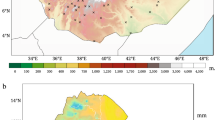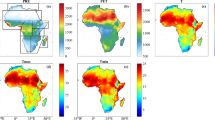Abstract
Development of downscaling models for each calendar month using the data of predictors specifically selected for each calendar month may assists in better capturing the time-varying nature of the predictor-predictand relationships. Such approach will not allow the explicit modelling of the persistence of the predictand (e.g. lag-1 correlation). However, downscaling at an annual time step and subsequent disaggregation to monthly values can explicitly consider the modelling of the persistence of the predictand. This study investigated the potential of annual downscaling of a predictand and subsequent disaggregation of annual values to monthly values, in comparison to the potential of downscaling models separately developed for each calendar month. In the case study, annual and monthly downscaling models were developed for precipitation and evaporation at two stations located in Victoria, Australia. The output of the annual downscaling models was then disaggregated into monthly values using four different methods based on the method of fragments. It was found that the annual to monthly disaggregation methods and monthly downscaling models are able to reproduce the average of monthly observations with relatively higher accuracy in comparison to their ability in reproducing standard deviation, skewness and lag-1 serial correlation. Downscaling models separately developed for each calendar month were able to show relatively smaller root mean square errors for their time series indicating better overall agreement with observations in comparison to their counterpart annual to monthly disaggregation methods. Furthermore, it was found that not only the bias in the output of an annual downscaling model but also the presence of annual totals in the records of observations of a predictand that are very similar in magnitude, but having significantly different sets of fragments, can largely contribute to the poor performance of an annual to monthly disaggregation method.








Similar content being viewed by others
References
Acharya A, Ryu J (2014) Simple method for streamflow disaggregation. J Hydrol Eng 19:509–519
Arsénio JJG (2003) Gestão de Albufeiras: avaliação do potencial dos sistemas com recurso a séries sintéticas de escoamentos (in Portuguese), Lisbon, Portugal. Master Thesis
Ashraf VS, Mousavi SJ, Abbaspour KC, Srinivasan R, Yang H (2014) Analyses of the impact of climate change on water resources components, drought and wheat yield in semiarid regions: Karkheh River Basin in Iran. Hydrol Process 28:2018–2032
Bürger G, Murdock TQ, Werner AT, Sobie SR, Cannon AJ (2012) Downscaling extremes—an intercomparison of multiple statistical methods for present climate. J Clim 25:4366–4388
Goly A, Teegavarapu RSV, Mondal A (2014) Development and evaluation of statistical downscaling models for monthly precipitation. Earth Interact 18:1–28
IPCC (2013) Climate Change (2013) The Physical Science Basis. Available at http://www.ipcc.ch/report/ar5/wg1/. Accessed 12 Dec 2015
Jeffrey SJ, Carter JO, Moodie KB, Beswick AR (2001) Using spatial interpolation to construct a comprehensive archive of Australian climate data. Environ Model Softw 16:309–330
Kannan S, Ghosh S, Mishra V, Salvi K (2014) Uncertainty resulting from multiple data usage in statistical downscaling. Geophys Res Lett 41:4013–4019
Kosaka Y, Xie SP (2013) Recent global-warming hiatus tied to equatorial Pacific surface cooling. Nature 501:403–407
Koza J (1992) Genetic programming: on the programming of computers by natural selection. MIT Press, Cambridge, Mass
Maheepala S, Perera B (1996) Monthly hydrologic data generation by disaggregation. J. Hydro. 178:277–291
Mahmood R, Babel MS (2013) Evaluation of SDSM developed by annual and monthly sub-models for downscaling temperature and precipitation in the Jhelum basin, Pakistan and India. Theor Appl Climatol 113:27–44
May RJ, Maier HR, Dandy GC, Fernando TMKG (2008) Non-linear variable selection for artificial neural networks using partial mutual information. Environ Model Softw 23:1312–1326. doi:10.1016/j.envsoft.2008.03.007
Najafi M, Moradkhani H, Wherry S (2011) Statistical downscaling of precipitation using machine learning with optimal predictor selection. J Hydrol Eng 16:650–664
Pascual D, Pla E, Lopez-Bustins JA, Retana J, Terradas J (2015) Impacts of climate change on water resources in the Mediterranean Basin: a case study in Catalonia. Spain Hydrolog Sci J 60:2132–2147. doi:10.1080/02626667.2014.947290
Porter JW, Pink BJ (1991) A method of synthetic fragments for disaggregation in stochastic data generation. Hydrology and Water Resources Symposium, Institution of Engineers, Australia, pp 187–191
Rayner, DP (2005) Australian synthetic daily Class A pan evaporation. Queensland Department of Natural Resources and Mines. Available at https://www.longpaddock.qld.gov.au/silo/publications.html. Accessed 20 Sep 2016
Sachindra DA, Huang F, Barton AF, Perera BJC (2013) Least square support vector and multi-linear regression for statistically downscaling general circulation model outputs to catchment streamflows. Int J Climatol 33:1087–1106
Sachindra DA, Huang F, Barton AF, Perera BJC (2014a) Statistical downscaling of general circulation model outputs to precipitation part 2: bias-correction and future projections. Int J Climatol 34:3282–3303
Sachindra DA, Huang F, Barton AF, Perera BJC (2014b) Statistical downscaling of general circulation model outputs to catchment scale hydroclimatic variables issues. Challenges and Possible Solutions Journal of Water and Climate Change 5:496–525. doi:10.2166/wcc.2014.056
Sachindra DA, Huang F, Barton AF, Perera BJC (2015a) Statistical downscaling of general circulation model outputs to evaporation, minimum temperature and maximum temperature using a key-predictand and key-station approach. Journal of Water and Climate Change 6:241–262. doi:10.2166/wcc.2014.145
Sachindra DA, Ng AWM, Muthukumaran S, Perera BJC (2015b) Impact of climate change on urban heat island effect and extreme temperatures: a case-study. QJR Meteorol Soc 142:172–186. doi:10.1002/qj.2642
Santos EG (1983) Disaggregation modeling of hydrologic time series. Thesis (PhD), Colorado State University, Colorado, USA
Silva AT, Portela MM (2012) Disaggregation modelling of monthly streamflows using a new approach of the method of fragments. Hydrolog Sci J 57:942–955
Srikanthan R, Mcmahon TA (1980) Stochastic generation of monthly flows for ephemeral streams. J. Hydro. 47:19–40
Tofiq FA, Guven A (2014) Prediction of design flood discharge by statistical downscaling and general circulation models. J Hydro 517:1145–1153
Volosciuk C, Maraun D, Semenov VA, Park W (2015) Extreme precipitation in an atmosphere general circulation model: impact of horizontal and vertical model resolutions. J Clim 28:1184–1205
Acknowledgments
The authors wish to thank the SILO team of the Queensland Climate Change Centre of Excellence, Australia, for their clarifications on observed data used in this study.
Author information
Authors and Affiliations
Corresponding author
Rights and permissions
About this article
Cite this article
Sachindra, D.A., Perera, B.J.C. Annual statistical downscaling of precipitation and evaporation and monthly disaggregation. Theor Appl Climatol 131, 181–200 (2018). https://doi.org/10.1007/s00704-016-1968-6
Received:
Accepted:
Published:
Issue Date:
DOI: https://doi.org/10.1007/s00704-016-1968-6




